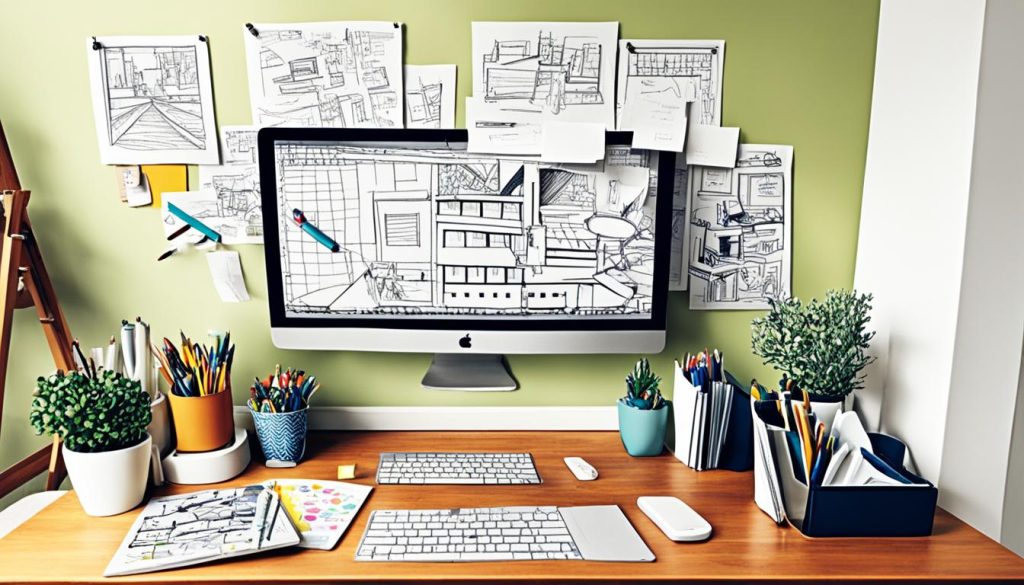Remote work has made it hard to separate work from home life. 80% of remote workers get sidetracked by family, pets, and more1. It’s important to find ways to stay focused. But maybe the key isn’t avoiding distractions, but learning to handle them well?
This guide will show you how to deal with distractions at home. You’ll learn to boost your productivity and balance work and life better. Get ready for lots of useful tips to make your home office a place of focus and efficiency.
Remote work has its upsides, but it also brings challenges. Studies say it can cut productivity by 10-20%1. But with the right strategies, you can stay focused and reach your goals, even from home.
Interruptions From Family Members
Working from home can be tough, especially with family around. It’s key to set boundaries and talk things out to keep your work going smoothly2.
Setting Boundaries for Uninterrupted Work
Setting clear boundaries with family is a smart move. This means picking a special spot for work and showing signs like a closed door or set “office hours” when you’re busy2.
Establishing “Office Hours” and Communication
It’s also vital to have set office hours and share them with your family. This helps manage their expectations and cuts down on interruptions when you’re in the zone. Talking ahead of time, like during regular check-ins or about meetings, helps keep things smooth and supports good remote communication at home2.
| Boundary Setting Techniques | Benefits |
|---|---|
| Designating a specific workspace or “office” area | Creates a clear line between work and home, cutting down on distractions |
| Communicating office hours and “do not disturb” signs | Helps set the rules and lowers interruptions during key work times |
| Scheduling regular check-ins and communicating important meetings | Boosts open communication and reduces surprise breaks |
Using these tips, you can make your work-from-home setup better, even with family around23.
Combating Social Media and Online Entertainment
The digital world is full of distractions, from social media to online entertainment. These distractions can really affect how productive you are when working from home4. In fact, 47% of people say that things like binge-watching movies and checking social media are big distractions for them at work4. To fight these distractions, it’s key to use strategies that help you stay focused.
Minimizing Distracting Windows and Notifications
One good way to stay focused is to close extra windows and turn off notifications5. A study from the University of California found that people get interrupted about 12 minutes into a task. It takes over 25 minutes to get back to work after an interruption5. By controlling your digital space, you can cut down on these breaks and stay productive.
Developing Digital Self-Discipline
It’s also important to have digital self-discipline5. A survey by CareerBuilder found that 55% of people see their cell phones as the biggest distraction at work. The Internet, gossip, and social media also ranked high on the list5. By setting limits on these distractions, you can take back control of your focus and make working from home better.
Being proactive about managing digital distractions can really boost your work-from-home productivity. Using these tips can keep you on track, focused, and meeting your work goals45.
Mitigating Outside Noise Interference
Noise from construction or loud neighbors can be a big distraction when you work from home. But, you can take steps to lessen these distractions. Soundproofing your office is a good way to make a quieter, more focused space6.
Dealing with Construction and Neighborhood Sounds
If the noise is not too loud but still bothers you, talk to your neighbors nicely to find a way to solve the problem6. Or, you could use noise-canceling headphones or apps that make background noise to cover up the unwanted sounds6.
| Mitigation Technique | Impact |
|---|---|
| Sound-masking systems | Make speech hard to understand, so you won’t be distracted by overheard talks6. |
| Sound-absorbing panels | Help reduce echoes and make speech clearer in open offices6. |
| Noise-canceling headphones | Are a great way to block out external noise6. |
| Ambient noise applications | Can help you focus and be more productive by creating calming sounds6. |
Some ambient noise can actually boost creativity and focus, studies show6. But too much noise can make you stressed, hurting your work and well-being6.
By tackling noise from outside, you can make your work area better and less distracting, whether it’s at home or in a shared office6. Trying out soundproofing, using noise-masking tech, and creating a calm space can really help you focus and do well while working remotely6.
Managing Visitors and Deliveries
Unexpected visitors and package deliveries can really throw off your uninterrupted work. It’s key to set clear rules for visitors and deliveries. With smart strategies, you can cut down on these distractions. This makes your home workspace better.
Start by giving clear directions to delivery people. Tell them where to leave packages or ask them to leave them at the door. This way, you won’t get interrupted all day by deliveries7.
For unexpected visitors, like friends or family, be clear about your work hours. Tell them you need focused time to work7. If you need to, use a digital system to check who comes in. This cuts down on distractions and keeps you safe8.
- Set clear rules for deliveries and visitors to keep your work flowing.
- Use digital tools to check who comes in and reduce interruptions.
- Tell your friends and family about your work hours to set clear expectations.
These steps help you work in a calm, distraction-free space. You’ll be more productive and keep a good balance between work and life while working from home78.

Arranging Reliable Childcare Solutions
Working from home can be tough when you have to balance work and childcare. Finding reliable childcare is key to focus on your job without interruptions9.
Exploring Childcare Options for Remote Workers
With more people working remotely, it’s important to look into childcare options. You might consider hiring a nanny, putting your child in part-time daycare, or creating a flexible schedule10.
Good communication is vital for Reliable Childcare. Talk clearly with your employer, partner, and kids to keep the workflow smooth and minimize interruptions11.
| Childcare Option | Advantages | Disadvantages |
|---|---|---|
| Hiring a Nanny | Personalized attention, flexible schedule | Higher cost, potential challenges with supervision |
| Part-Time Daycare | Structured environment, social interaction | Limited availability, potential waitlists |
| Flexible Schedule | Ability to manage childcare, work during child’s naps | Potential challenges with productivity, work-life balance |
Looking into these Childcare Solutions and finding the right balance helps you work better from home91011.
Handling Pet Distractions
Pets can be great friends but they can also interrupt our work. During important meetings or calls, their presence can be a big distraction. To keep your work on track, it’s important to find ways to keep pets away from your workspace12.
Separating Pets from Your Workspace
One good way is to give your pets their own spot away from your work area. This could be with toys, beds, or a special “pet zone” in another room13. This helps keep them busy and out of your way while you work.
Also, teach your pets to know when you’re busy. Use treats to praise them for being quiet and calm when you’re working13.
If your pets keep bothering you, you might need to try harder methods. Using noise-canceling headphones or white noise machines can help block out any sounds they make12. By managing pet distractions, you can work better and give your best effort without interruptions.
Avoiding Housework as a Procrastination Tactic
Working from home can make it tempting to do household chores during work hours. But, this can hurt your productivity and focus. It’s key to schedule chores outside work time to stay focused on your job.
Scheduling Chores Outside Work Hours
The “two-minute rule” is a good way to stop using housework to avoid work. David Allen, a productivity expert, says do tasks that take less than two minutes right away14. This includes things like checking emails, watering plants, and cleaning up quickly14.
This rule says it’s better to do small tasks now than to keep track of them later14. Doing these small chores as they come up stops them from building up and causing stress14.
Also, breaking big chores into smaller tasks helps you get started and keep going14. This way, you avoid putting things off, celebrate small wins, and stay active14.
But, be careful not to switch tasks too much and make sure you’re focusing on what’s important14. Set aside time for chores outside work hours to keep your focus sharp and avoid using housework as an excuse to not work14.
| Distraction | Impact | Productivity Tips |
|---|---|---|
| Housework and Chores |
By focusing on your work and doing chores outside work hours, you can avoid using housework as an excuse to not work. Using strategies like the two-minute rule and having a dedicated work space helps you stay focused and reach your goals161415.
Managing Distractions in Work From Home Offices
If your home office is too distracting, think about trying coworking spaces or remote setups. These options give you a place to work without interruptions17. Studies say multitasking can cut productivity by up to 40%17. Also, taking short breaks after 52 minutes can boost your productivity and focus17.
Utilizing Coworking Spaces and Remote Setups
Coworking spaces give you a professional place to work, helping you keep work and personal life separate18. Having a set workspace helps you avoid distractions and improves your work-life balance18. Remote setups, like serviced offices or virtual offices, offer the tools and structure you need to stay productive at home18.
Looking at your work space and making changes can keep you productive and focused17. Setting clear work and home boundaries can increase productivity by up to 75%17. Using strategies to block tech distractions, like turning off notifications and using website blockers, can cut down on wasted time by 50%17.
| Key Benefits of Coworking Spaces and Remote Setups | Coworking Spaces | Remote Setups |
|---|---|---|
| Dedicated Workspace | ✓ | ✓ |
| Reduced Distractions | ✓ | ✓ |
| Improved Work-Life Balance | ✓ | ✓ |
| Access to Professional Equipment | ✓ | ✓ |
| Networking Opportunities | ✓ | – |
| Flexible Lease Options | ✓ | ✓ |
Looking into coworking spaces or remote work setups can make your work environment better. It helps you manage distractions and stay focused on your tasks1718.
Optimizing Your Home Office Environment
Creating a productive home office environment is key for remote workers. By organizing your workspace well, you can cut down on distractions and boost your productivity19.
First, set up a dedicated workspace that fits your needs. Pick a spot with lots of natural light, as it can make you 20-25% more focused20. Make sure it’s well-ventilated and at a good temperature, as this can make you up to 10-15% more productive20.
- Invest in ergonomic furniture and equipment, like a comfy chair and an adjustable desk, to help you stay in good posture and avoid strain.
- Use efficient storage to keep your space tidy and save time looking for things, which can make you 15-20% more efficient20.
- Keep your workspace clean and organized, as a neat area can cut stress by 10-15% and make you happier at work20.
Using digital tools and tech can also make your Home Office Environment better. Tools like Dropbox, Google Drive, and Microsoft OneDrive help with sharing files securely, working together, and getting to your stuff easily19.
By making your workspace ergonomic, pleasing to the eye, and tailored to your work style, you can reduce distractions and get more done19. Don’t forget to take breaks, keep a good balance between work and life, and use time-tracking tools19.
Finally, making your Home Office Environment the best it can be is key to a productive and satisfying remote work life. By following these tips, you can set up a space that helps you stay focused, efficient, and healthy19.
Incorporating Scheduled Breaks and Recharging
To stay focused and productive while working from home, make sure to take breaks on purpose21. Studies reveal that checking the internet or doing personal stuff doesn’t boost your work output or energy21. Try the Pomodoro method, which mixes short and long breaks with focused work. This can cut down on mental tiredness and back pain21.
- Take regular breaks to recharge and refresh your mind. Even a short 5-10 minute break can greatly improve your energy and focus.
- Do things that help you relax and unwind, like meditation21, or a quick walk21. These activities can increase your energy as much as a cup of coffee, without the side effects.
- Don’t let your breaks turn into personal tasks or internet surfing, as it can hurt your productivity21.
Adding scheduled breaks and recharging strategies to your workday helps keep a good balance between work and life22. Taking breaks is key to staying focused and fighting mental tiredness22. Short walks or mindfulness during breaks can help you recharge and tackle your tasks with more energy and focus22.

Finding the right mix of work and rest is crucial for success22. Try out different methods and see what suits you best to stay sharp and energized all day22.
| Scheduled Breaks | Productivity Breaks | Recharging Strategies |
|---|---|---|
| Pomodoro Technique | Short Bursts of Focused Work | Meditation |
| Regular 5-10 minute breaks | Avoiding Distractions | Exercise |
| Timed Break Reminders | Maintaining Concentration | Mindfulness Exercises |
Proper Scheduling and Time Blocking
Working from home comes with its own set of challenges. To overcome these, effective time management is crucial. By setting clear boundaries between work and personal life, you can dedicate specific times for each. This approach helps maintain a good work-life balance and keeps distractions at bay23.
Allocating Time for Work and Personal Activities
Time blocking means dividing your day into set times for work and personal tasks. This method helps you focus on one task at a time, boosting your productivity23. On the other hand, time boxing limits the time you spend on a task. It encourages you to work efficiently and avoid overdoing it23.
Day theming is another useful strategy. It assigns a theme to each day of the week, dedicating each day to a specific task or project. This method clears your mind and reduces decision fatigue23. Task batching groups similar tasks together in set times. It saves time and mental energy by cutting down on switching between tasks23.
| Scheduling Technique | Description | Benefits |
|---|---|---|
| Time Blocking | Dividing the day into specific blocks of time for focused work and personal tasks | Promotes “deep work,” enhances productivity, and prevents overworking |
| Time Boxing | Setting a limited amount of time for a task | Encourages efficiency and prevents overworking |
| Day Theming | Assigning different themes to each day of the week and dedicating each day to a specific type of task or project | Provides mental clarity and limits decision fatigue |
| Task Batching | Grouping similar tasks together and completing them in dedicated time blocks | Saves time and mental energy by reducing context-switching |
Using these Scheduling Techniques, Time Blocking, and keeping a good Work-Life Balance helps you manage your time well. It boosts productivity and ensures a balanced life while working from home232425.
Remember, the secret to great time management is being intentional with your time. Prioritize your tasks and protect your scheduled time from distractions and interruptions25.
Eliminating Multitasking During Work Hours
Many think multitasking is a great skill, but research shows it can hurt productivity and make it harder to stay focused when working from home26. People who multitask or switch tasks often take 50% more time to finish a job and are 40% less productive27. To stay Focused Work and boost Productivity Improvement, it’s key to Avoid Multitasking and focus on one task at a time during work hours.
Workers spend about three hours a day just checking work emails27, and over 70% of smartphone users check their phones every hour or more27. This constant task-switching and device-checking can really mess with your focus and lower your productivity26. To fight this, try to avoid switching between different tasks and block out distracting windows and notifications during work.
Multitasking and too much tech can overwhelm you with information, making you less productive27. But, just 10 minutes of mindfulness meditation can help you refocus and calm down27. Using attention management strategies, like taking breaks and keeping work separate from personal life, can make you feel more in control of your time27.

By stopping multitasking and focusing on one task at a time, you can boost your Focused Work and overall Productivity Improvement while working from home26. Set clear boundaries, reduce distractions, and practice mindfulness to get better at Avoiding Multitasking and succeeding in your remote job.
Allowing Warm-Up Time Before Starting Work
Starting work after personal time can be hard for many remote workers, often leading to putting things off. To fight this, add a Warm-Up Time to your daily plan. This helps your brain slowly get ready to focus and work well, cutting down on distractions28.
Start your workday with a Productivity Ritual that gets your mind ready for what’s next. This might be simple stretches, meditation, or checking your to-do list. Doing these thoughtful activities can stop you from delaying and make your day more productive28.
Research says that listening to music while working can make you think better, especially with classical music and nature sounds29. Also, using colors like blue and yellow in your office can lessen stress and boost creativity29.
Setting aside a few minutes for your Warm-Up Time before starting work can boost your focus, help you prioritize tasks, and keep a good balance between work and life. Small changes in your daily routine can greatly improve your productivity and happiness28.
| Technique | Benefits |
|---|---|
| Warm-Up Time | Improved focus, reduced procrastination |
| Productivity Ritual | Prepares the mind for work, enhances motivation |
| Background Music | Boosts cognitive performance, promotes concentration |
| Workspace Colors | Blue: Reduces stress, Yellow: Sparks creativity |
| Comfortable Temperature | Positively impacts focus and motivation |
Using these strategies can make your workday start smoothly, creating a better remote work setting2829.
By adding a warm-up routine and making your workspace better, you can improve your time management and work better from home2829.
Establishing Boundaries and Expectations
More people are working from home now, thanks to the rise in remote work30. But, it comes with its own set of challenges, like distractions30. To overcome these, setting clear boundaries and expectations is key. This is important for both you and your work or family life.
Creating an Office-Like Environment at Home
Having a dedicated workspace at home helps remote workers stay focused and productive30. Think of this spot as your personal office. Make sure you have all the tools you need to do your job well. Stick to a daily routine and let your family know when you’re working to avoid interruptions30.
Also, avoiding social media during work hours helps you concentrate better and reduces distractions30. Keep your tasks in order and stay organized to handle distractions well30.
Setting mental boundaries, like having rituals to mark the start and end of work, helps prevent burnout for remote workers30. Taking breaks regularly is also crucial for staying productive and avoiding burnout while working from home30.

| Establishing Boundaries | Work Expectations | Home Office Environment |
|---|---|---|
|
|
|
By setting clear boundaries and expectations, remote workers can make their home office work well. This helps them stay productive, manage distractions, and keep a good work-life balance303132.
Identifying Triggers for Unproductivity
Knowing what makes you unproductive is crucial when working from home. Being self-aware helps you spot these triggers. This lets you find ways to stay focused all day.
Look at your daily habits closely. What makes you lose focus or get distracted? Is it your phone’s constant notifications? The urge to scroll through social media? Or maybe household chores seem more appealing33. Companies lose hundreds of billions each year because of distractions at work33. Knowing these Unproductivity Triggers helps in Distraction Mitigation.
- Find the main distractions that interrupt your work, like phones, internet, or gossip33.
- See how things like clutter or being hungry affect your focus33.
- Think about when you work best and when you struggle with Unproductivity Triggers33.
With this Self-Awareness, you can make your workspace better and work habits to reduce distractions. About 79% of workers feel distracted, and 68% can’t focus well34. Taking steps to deal with your Unproductivity Triggers can help you focus better and reach your full potential.
Understanding yourself and what affects your work is the first step to being more productive. By knowing your Unproductivity Triggers and using Distraction Mitigation strategies, you can work better, even at home34.
Turning Off Devices and Notifications
In today’s digital world, constant notifications and distractions can hurt productivity when working from home35. Notifications are key in the digital age, trying to grab our attention with messages35. Turning off these alerts can make us more focused and productive by cutting down on distractions35. They tell us about new messages, dates, and other important stuff35.
Removing Technological Distractions
To fight distractions, we need to turn off or mute our devices and alerts35. Each device has its own way to disable notifications, like iPhones, Androids, Windows PCs, and macOS35. For work tools, like project management software, notifications are key35. For instance, Kumospace, a web conferencing tool, uses notifications for alerts and chat requests35. To get desktop notifications from Kumospace, you need to adjust the settings and allow them in your browser35.
Turning off notifications can really boost productivity36. Workers often spend three or more hours a day on emails and messages, leaving little time for focused work36. Also, people spend about two hours daily on social media, which can lead to wasting time36. By cutting down on these distractions, you can get back valuable time and focus better36.

Studies also show that having control over our digital spaces makes us happier37. By managing our digital world and reducing distractions, we can work more efficiently and enjoyably37.
Listening to Your Body and Taking Breaks
Working from home comes with its own set of challenges. It’s important to pay attention to what your body and mind are telling you. Sometimes, you just need to take a break and recharge. Knowing when to step away is crucial for staying focused and performing well over time.
Studies show that distractions at work can really hurt productivity. Most workers say a distracting work environment is a big problem38. It can take more than 23 minutes to get back on track after getting distracted38. By listening to your body, you can stop these problems before they start and avoid burnout.
Whether you need a short break, a change of environment, or just some quiet time, paying attention to your body’s signals is key. Using good time management39 can help you keep your productivity up while working from home. Remember, keeping a good balance between work and life is key to your long-term success and happiness.
Source Links
- https://hubstaff.com/blog/work-from-home-distractions/
- https://karbonhq.com/resources/limit-distractions-and-interruptions-to-improve-your-remote-working-life/
- https://wingassistant.com/distractions-while-working-remotely/
- https://blog.ahsuite.com/working-from-home-distractions/
- https://clockify.me/blog/productivity/workplace-distractions/
- https://fastercapital.com/content/Eliminating-Distractions–Ambient-Noise-Control–A-Solution-for-Eliminating-Distractions.html
- https://www.technosis.biz/blog/2021/8/10/preventing-workplace-distractions-randolph-wi
- https://thereceptionist.com/blog/5-types-of-common-distractions-to-eliminate-from-your-office-today/
- https://www.askamanager.org/2022/10/we-need-to-tell-our-remote-employees-they-cant-take-care-of-young-kids-while-theyre-working.html
- https://www.procaresoftware.com/blog/parent-like-a-provider-how-to-work-from-home-with-kids-during-covid-19/
- https://www.careforkids.com.au/blog/tips-to-help-you-balance-work-and-child-care-at-home
- https://trucesoftware.com/blog/how-to-immediately-reduce-workplace-distractions/
- https://www.theverge.com/23274524/work-from-home-distractions-wfh-how-to
- https://todoist.com/inspiration/two-minute-rule
- https://heyfocus.com/blog/remote-work-productivity-dangers-a-guide-to-optimizing-your-time-and-preventing-distractions/
- https://www.additudemag.com/how-to-stay-focused-adhd-wfh/
- https://arc.dev/talent-blog/wfh-remote-work-distractions/
- https://vault.com/blogs/productivity/how-to-avoid-distractions-when-working-from-home
- https://www.kumospace.com/blog/virtual-office-the-future-of-remote-working
- https://vault.com/blogs/workplace-issues/7-ways-to-optimize-your-workspace-for-better-health-and-productivity
- https://www.lucidchart.com/blog/why-take-breaks-while-working-from-home
- https://www.linkedin.com/pulse/how-set-up-distraction-free-home-office-maximum-robert-baines
- https://todoist.com/productivity-methods/time-blocking
- https://asana.com/resources/what-is-time-blocking
- https://humanwhocodes.com/blog/2023/07/managing-interrupt-rate-tech-lead-time-blocking/
- https://www.linkedin.com/pulse/how-manage-distractions-while-working-from-anywhere-steve-todd
- https://bewell.stanford.edu/letting-go-of-distractions/
- https://www.handdy.com/how-to-limit-distractions-while-working-from-home/
- https://www.opal.so/blog/20-practical-tips-for-keeping-focus-while-working-from-home
- https://www.remotepass.com/blog/managing-distractions-working-from-home
- https://www.forbes.com/sites/carolinecenizalevine/2020/06/07/how-to-set-boundaries-between-work-and-home/
- https://www.linkedin.com/pulse/remote-work-how-set-boundaries-when-office-your-house-lora-vaughn
- https://www.businessnewsdaily.com/8098-distractions-kiling-productivity.html
- https://empmonitor.com/blog/workplace-distractions-solutions/
- https://www.kumospace.com/blog/turn-off-notifications
- https://neat.no/resources/11-ways-to-mitigate-technology-distractions-in-the-workplace/
- https://maurathomas.com/distractions-work-from-home/
- https://plan.io/blog/minimize-distraction/
- https://rize.io/blog/how-to-stay-focused-working-from-home

